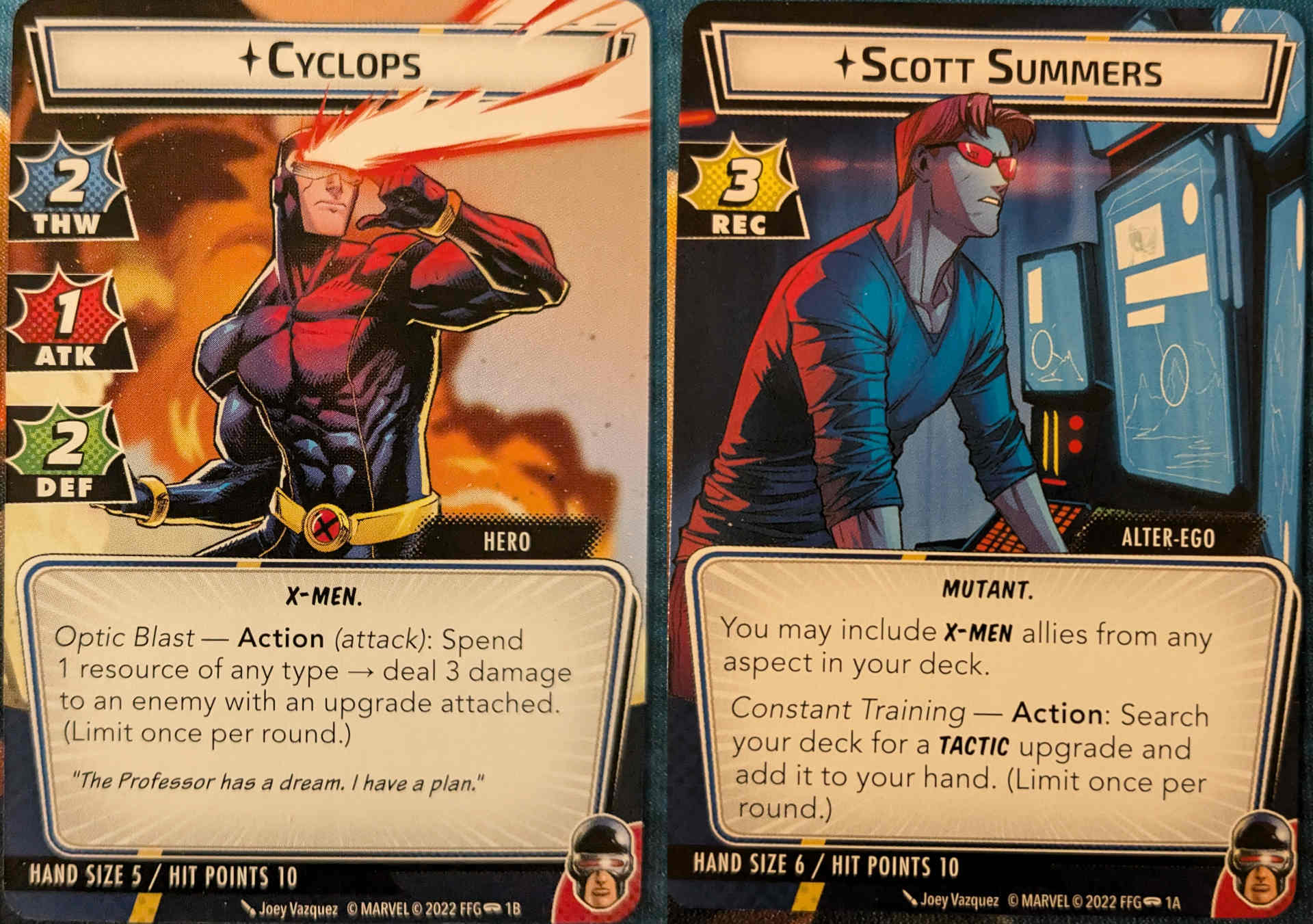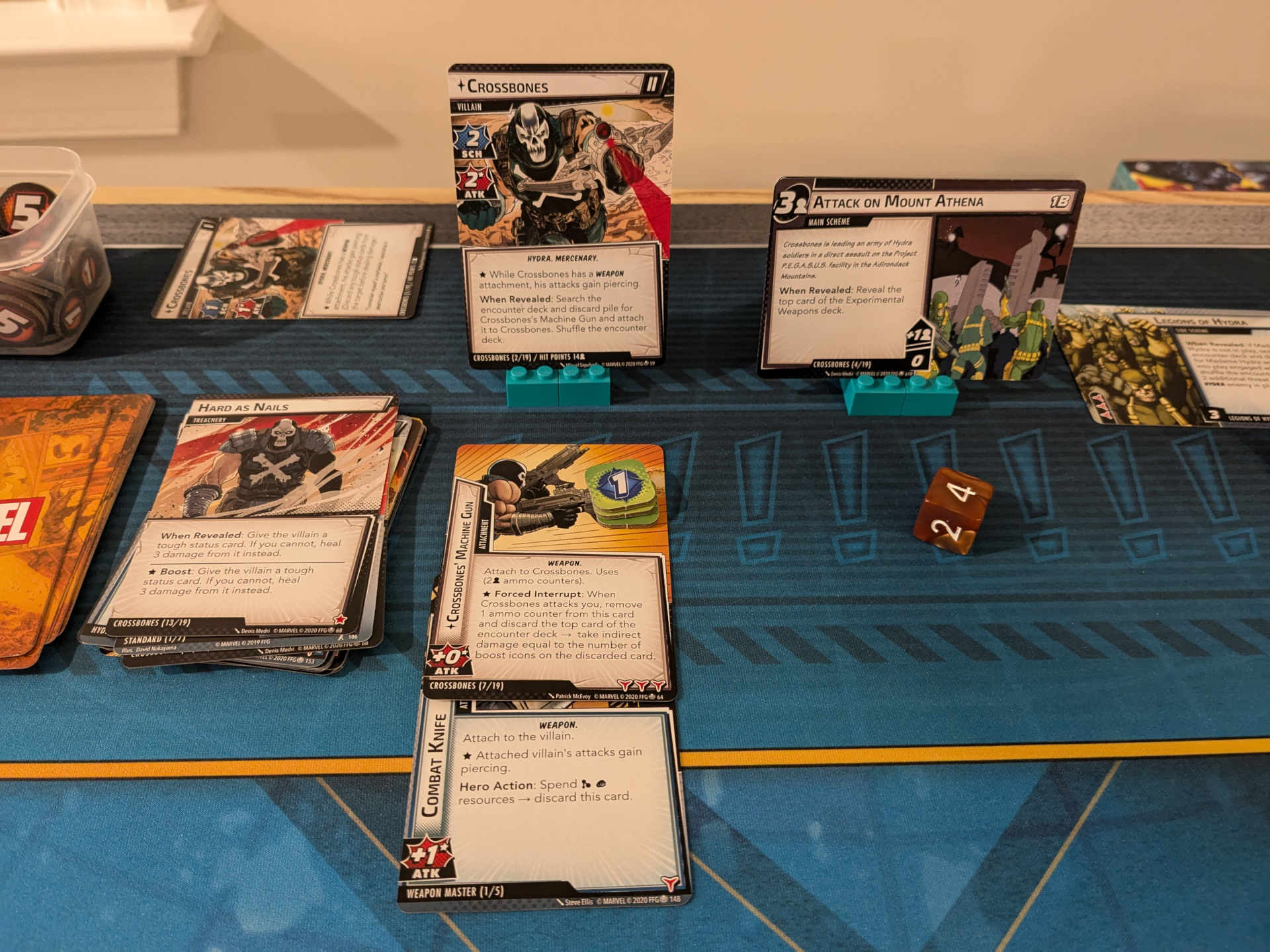Introduction #
Ah, Marvel Champions–where I can finally live out my dream of being both Peter Parker and Spider-Man in the same day, without needing to worry about a radioactive spider bite. If you’re like me and enjoy a good strategy game but also love to nerd out over superheroes, then you might already have Marvel Champions on your radar. It’s a cooperative living card game (LCG) set in the Marvel universe, and yes, it can be played solo–which is my primary mode of play these days.
But let’s be real, superhero games can be hit or miss. Sometimes they’re all about big, splashy moves with little thought behind them, or they’re more like roll-and-punch fests. Marvel Champions, however, strikes a balance between theme, strategy, and smart mechanics that just works. So let’s dig into what makes this game not just another piece of Marvel merch, but a genuinely engaging solo gaming experience.
Review images contain heroes and villains from expansions, but the essence and gameplay are the same.
Overview #
At its core, Marvel Champions is a cooperative card game where you play as a Marvel hero facing off against a villain, and your goal is to stop them from completing their dastardly schemes. The villain? Crafty. The heroes? Resourceful. The gameplay? Fast-paced, strategic, and very much in line with the powers and personalities of your favorite Marvel icons.
Here’s how it works: You choose a hero, maybe Iron Man or Black Panther–take your pick, then you take their base hero deck of cards that represent their abilities, equipment, and allies. These are supplemented by one of four “aspects,” Aggression, Justice, Leadership, or Protection, which further customize how your hero handles the villain’s challenges. The villain also has a deck, filled with their own plans and minions, and they’ll throw everything from minions to surprise attacks your way as you try to keep their nefarious schemes in check.
You’ll go round after round in a bout against your chosen villain. Each round consists of two main phases:
- Hero Phase: Players take their turns playing cards, taking actions, attacking, thwarting schemes, and switching between hero and alter-ego forms.
- Villain Phase: The villain schemes and retaliates.
Let me tell you, the villains do not pull their punches. The balance between offense, defense, and strategic planning is key. You’ll need to thwart the villain’s schemes while also dealing damage, managing resources, and flipping between your hero and alter-ego forms to stay alive. Yes, Peter Parker needs to work on his chemistry homework, but Spider-Man still has to stop Rhino from smashing into the city. It’s a beautiful kind of chaos.

To win, you need to lay the beat-down on the villain to bring their health to zero, not just once, but twice! The villain powers up after the first beat-down and gets their second wind. They shift into a more dangerous version of themselves and you better believe they won’t go down again without putting up a fight.
Gameplay #
Let’s talk hero turns. This is where Marvel Champions shines–especially in solo play. You’re not just mindlessly playing cards; you’re juggling multiple priorities in a way that feels dynamic and rewarding. Do you focus on taking out minions or thwart the villain’s scheme? Maybe you have the perfect combo to chip away at the villain’s health, but if you don’t block that attack, you’ll be in serious trouble next turn. The choices are endless, and each one can feel like the right—or wrong—one at any given moment. For solo, the gameplay can feel pretty different if you choose to play true solo with just one hero or multi-handed controlling more than one hero yourself.
There’s something incredibly satisfying about planning out a turn where you chain a series of actions that leave your villain shaking in their boots. You might suit up with Iron Man’s armor pieces, unleash a series of devastating repulsor blasts, then finish by swapping to Tony Stark’s alter-ego form to heal up and recharge. Or maybe you’re Black Panther, setting up your Wakanda Forever attack, chaining together different equipment for a massive strike. The combo potential is immense, and it feels so good when you pull off something big.

But perhaps the most fun part of the game is switching between your hero and alter-ego forms. Marvel Champions takes a really clever approach here, leaning into the characters’ dual lives. Spider-Man is agile and resourceful, but sometimes Peter Parker just needs to take a step back and deal with his personal life. Switching to your alter-ego might let you heal or draw more cards, but you’ll also leave the villain free to scheme while you’re busy being a “regular person.” The tension in deciding when to shift is palpable and adds a layer of decision-making that feels both thematic and strategic. Aunt May’s cookies may heal Peter up, but Rhino isn’t going to wait politely while you have a snack.

Deck construction in Marvel Champions also deserves praise for its simplicity and flexibility. While some card games can overwhelm you with deck construction options, here, each hero has their own hero kit, which you can then customize by adding one of four aspects. Aggression, Justice, Leadership, and Protection each give your deck a certain flavor to reel in the deck construction choices. Do you want to go all-out attack, focus on protecting yourself and allies, or work to shut down the villain’s schemes? It’s enough flexibility to make every game feel different without bogging you down in hours of deck construction decisions.
Lastly, let me warn you–if you haven’t dabbled in card combat games before, Marvel Champions can be a bit of a brain-bender! Even seasoned card gamers might stumble over some of its nuances and unique mechanics. If you’re not paying attention, it’s easy to misinterpret the rules. Like most games of this genre, Marvel Champions comes with its fair share of FAQs and errata for how certain cards interact, bend, or even break the base rules from the rulebook by design. My advice? Do yourself a favor and dive into videos and forum threads where players break down common mistakes and tricky rule interactions–you’ll thank yourself later!

Components and Design #
Let’s talk about what you’re physically getting here–because, as we all know, components matter. Marvel Champions doesn’t disappoint, offering a ton of variety in cards, all decked out (pun intended) with vibrant comic book art. You’ve got everything from action-packed hero poses to villainous snarls and explosions, and it feels like you’re flipping through a Marvel comic with every draw.
The health dials for both heroes and villains are nice quality and a step up from the usual token-based systems. That being said, everything else is token-based. I have to recommend using dice as counters instead of the default tokens as it’ll help you read the game state at a glance instead of constantly counting tokens–trust me, your sanity will thank you.

What about theme? The designers clearly spent time making sure the mechanics fit the characters, and it shows. Spider-Man is all about agility and using resources cleverly, while Iron Man feels naked without his iron suit. The alter-ego mechanic is also incredibly thematic, as I mentioned earlier. There are moments where Jennifer Walters, She-Hulk’s alter-ego, can handle a situation better than She-Hulk ever could. This duality between superhero and civilian life is really what makes Marvel Champions stand out in terms of theme–it doesn’t just tack the Marvel license on; it feels like it belongs in this universe.
And let’s not forget the villains. Each one feels unique, not just in their art and theme but in how they operate. Whether it’s Ultron flooding the board with drones or Rhino just Breakin’ & Takin’, the villains bring their own character to each encounter, making them more than just a punching bag for your hero’s massive combos.
Final Thoughts #
At the end of the day, Marvel Champions is a blast to play solo. It captures the essence of being a superhero without skimping on strategic depth. Whether you’re a Marvel fan looking for a thematic experience or a strategy gamer hunting for a solo-friendly, tactical challenge, this game fits the bill.
What really elevates Marvel Champions beyond just a “beat up the bad guy” card game is the careful blend of theme, mechanics, and flexibility. The game doesn’t require hours of deck construction, but it gives you enough control to craft a playstyle that feels unique to your chosen hero and you can still nerd out for hours upon hours if you want to. Switching between hero and alter-ego forms, making tough decisions about when to defend, attack, or heal–it all adds up to an experience that feels as much about surviving the villain’s onslaught as it is about unleashing your hero’s full potential.
Sure, you could argue that it’s a bit fiddly keeping track of all the tokens and counters (dice, people, I’m telling you, dice), but that’s a small price to pay for a game that nails the superhero feel so well. This one is going to have a LOOOONG shelf life, especially if you’re like me and enjoy getting lost in a game that makes you feel like you’re one mask and spandex suit away from saving the world.
We purchased this product independently. All opinions expressed are independent, honest, and unbiased.
- The game perfectly captures the Marvel superhero experience, balancing action and strategy.
- Switching between hero and alter-ego forms adds tension and depth, making every turn feel impactful.
- Multiple heroes, aspects, and deck construction options offer variety and replayability without overwhelming complexity.
- Chaining hero abilities feels powerful and rewarding, especially when executed in strategic bursts.
- Exciting interactions between heroes whether its defending or lending a hand to keep a combo going.
- The rules can be tricky, especially for players new to card combat games, with plenty of FAQs and errata to consider.
- The game requires managing multiple tokens and counters, which can feel fiddly and cumbersome.
Learn more about how we rate board games...
